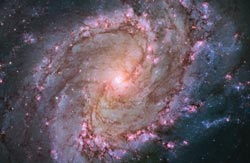Hubble Views Stellar Genesis in the Southern Pinwheel

This Hubble mosaic of the spiral galaxy M83 or Southern Pinwheel, lies 15 million light-years away in the constellation Hydra. It contains thousands of star clusters, hundreds of thousands of individual stars, and "ghosts" of dead stars called supernova remnants. <br>Image Credit: NASA, ESA/HHT/STScI/AURA/W.Blair, JHU/R.O'Connell, UV<br>
The vibrant magentas and blues reveal the galaxy is ablaze with star formation. The galaxy, also known as the Southern Pinwheel, lies 15 million light-years away in the constellation Hydra.
The Hubble photograph captures thousands of star clusters, hundreds of thousands of individual stars, and “ghosts” of dead stars called supernova remnants. The galactic panorama unveils a tapestry of the drama of stellar birth and death spread across 50,000 of light years.
The newest generations of stars are forming largely in clusters on the edges of the dark spiral dust lanes. These brilliant young stellar groupings, only a few million years old, produce huge amounts of ultraviolet light that is absorbed by surrounding diffuse gas clouds, causing them to glow in pinkish hydrogen light.
Gradually, the fierce stellar winds from the youngest, most massive stars blow away the gas, revealing bright blue star clusters and giving a “Swiss Cheese” appearance to the spiral arms. These youngest star clusters are about 1 million to 10 million years old. The populations of stars up to 100 million years or older appear yellow or orange by comparison because the young blue stars have already burned out.
Interstellar “bubbles” produced by nearly 300 supernovas from massive stars have been found in this Hubble image. By studying these supernova remnants, astronomers can better understand the nature of the stars that exploded and dispersed nuclear processed chemical elements back into the galaxy, contributing to the next generation of new stars.
This image is being used to support a citizen science project titled STAR DATE: M83. The primary goal is to estimate ages for approximately 3000 star clusters. Amateur scientists will use the presence or absence of the pink hydrogen emission, the sharpness of the individual stars, and the color of the clusters to estimate ages. Participants will measure the sizes of the star clusters and any associated emission nebulae. Finally, the citizen scientists will “explore” the image, identifying a variety of objects ranging from background galaxies to supernova remnants to foreground stars.
STAR DATE: M83 is a joint collaborative effort between the Space Telescope Science Institute and Zooniverse, creators of several citizen science projects including Galaxy Zoo, Planet Hunters and the Andromeda Project (go to www.zooniverse.org to see the full list). The M83 project is scheduled to launch on Monday, January 13, 2014. People interested in exploring this remarkable image in more detail, and in directly participating in a science project, can visit: http://hubblesite.org/news/2014/04
Space Science Telescope Institute/Zooniverse project
Media Contact
All latest news from the category: Physics and Astronomy
This area deals with the fundamental laws and building blocks of nature and how they interact, the properties and the behavior of matter, and research into space and time and their structures.
innovations-report provides in-depth reports and articles on subjects such as astrophysics, laser technologies, nuclear, quantum, particle and solid-state physics, nanotechnologies, planetary research and findings (Mars, Venus) and developments related to the Hubble Telescope.
Newest articles

Superradiant atoms could push the boundaries of how precisely time can be measured
Superradiant atoms can help us measure time more precisely than ever. In a new study, researchers from the University of Copenhagen present a new method for measuring the time interval,…

Ion thermoelectric conversion devices for near room temperature
The electrode sheet of the thermoelectric device consists of ionic hydrogel, which is sandwiched between the electrodes to form, and the Prussian blue on the electrode undergoes a redox reaction…

Zap Energy achieves 37-million-degree temperatures in a compact device
New publication reports record electron temperatures for a small-scale, sheared-flow-stabilized Z-pinch fusion device. In the nine decades since humans first produced fusion reactions, only a few fusion technologies have demonstrated…





















